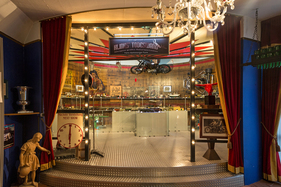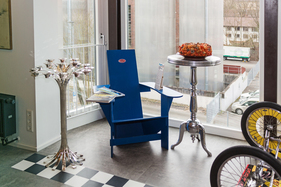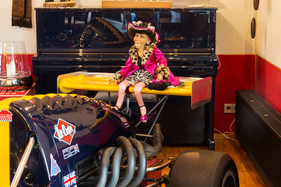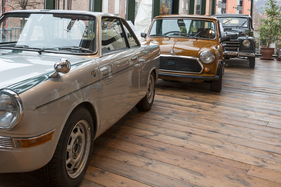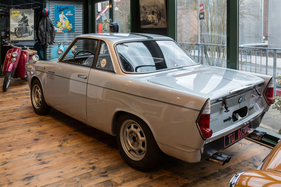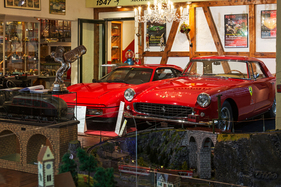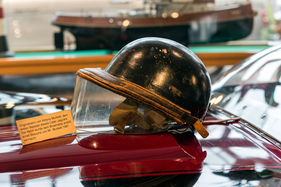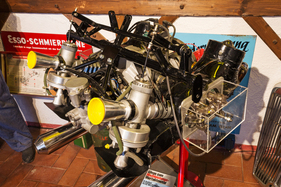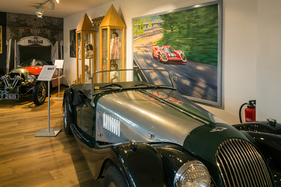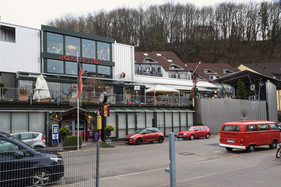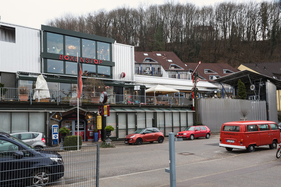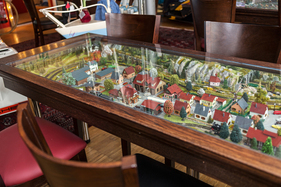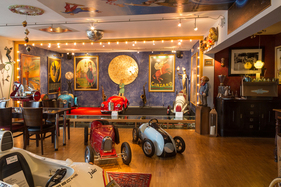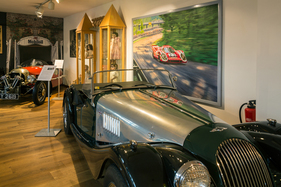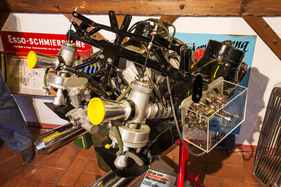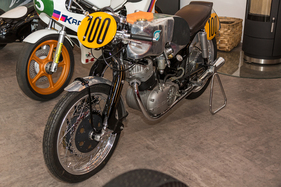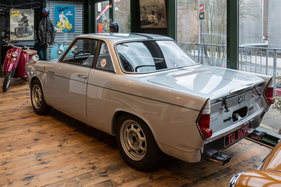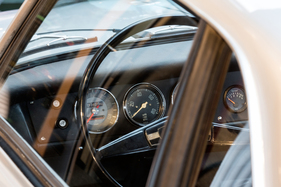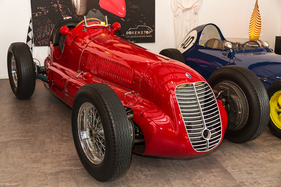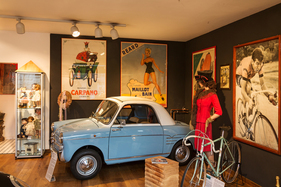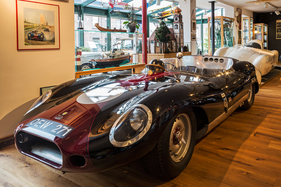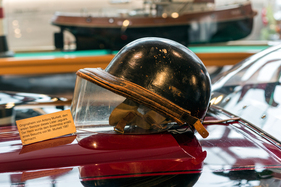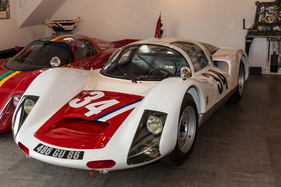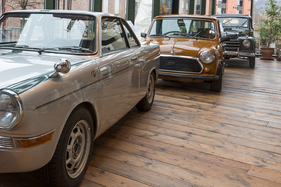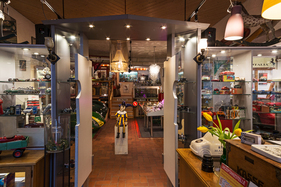"The days when it was enough to screw a car museum sign onto a hall full of cars and motorcycles and wait for visitors are over," Reiner Klink greets me. His aim is to create an active museum that involves visitors in the events, a world of experience for the whole family. Because only when you experience a hobby together, he says, does everyone get something out of it, and that's the way it should be on a weekend trip.
Even after the first half hour, it's not just the men who should still be having fun, but everyone who has come here. One of his role models is the Swiss Museum of Transport, even if he deliberately does not aspire to its size. Okay, that all sounds promising at first, I'm curious to see whether he can keep his promise.
I am surprised by the huge Märklin exhibition on the first floor, which will be dismantled at the end of the winter to make way for the vintage cars that are otherwise on display there. "While other museums close for the winter, we have attracted almost 10,000 visitors," says Reiner Klink and is delighted to see a Swiss railroad fan admiring the Glacier Express made by Märklin. The concept seems to be working.
The aim of the unusual museum is not mass but class, which nevertheless brings together 85 impressive vehicles, a toy collection with over 2500 exhibits and countless two-wheelers under one roof. Visitors can experience the cars up close, i.e. without the extensive barriers that usually separate them from the exhibits. All of this is spread over 4 floors and needs to be worked out.
The former bus depot was converted into a museum in 1985 and has been continually extended and expanded ever since. The last, fourth conversion added a further 200 m² of exhibition space on the top floor, making a total of 1200 m². The work in the museum, which was open in the meantime, took almost six months, and the building permit from the city took six times as long ...
In the meantime, we have settled down in the restaurant in the "Rastelli" room, named after the world's greatest juggler before the Second World War. In keeping with the idea that various themed rooms should take visitors on a journey into the past, the atmosphere here is one of circus and vaudeville. Each floor has its own character and all areas are individually decorated with a striking attention to detail. Anyone entering a room for the second time will discover new details that they had previously missed.
The museum, which is located near the popular old town of Tübingen, has four pillars:
- The classic museum business
- Gastronomy with its own restaurant and kitchen
- classic car tours
- rallies
Gastronomic experience
Here you sit in the middle of the exhibits, under the glass table tops there is a lot to discover, for example a model train that can be driven. And it's not just the little visitors who enjoy it. Not surprisingly, the rooms are often booked for parties and other events. The adjoining terrace is also open to the public and is very popular in good weather.
Interesting classic car tours
Now a market leader, this section began in 1993 with a classic car trip to Paris for the Retromobile, probably one of the first well-organized events of its kind at the time. This has now developed into around 30 trips a year. We travel to Le Mans, Goodwood, the Mille Miglia and other destinations in a comfortable coach, or we travel in our own classic car, as we did to St. Petersburg for the 20th anniversary, or to other interesting destinations.
Almost half of all participants on the trips are women, so the program on offer must appeal to both sexes equally. A well-prepared tour book is created when Mr. and Mrs. Klink drive the planned trip beforehand and therefore know exactly which route is suitable.
The daily stages of approx. 200 km give everyone enough time to organize the day according to their own ideas, with the only fixed date being the joint dinner with the riders' briefing for the next day. For emergencies, the former pit stop race transporter is available, which also takes care of luggage transportation. Anyone arriving at the hotel in the evening will find their suitcases already in their room.
Varied rallies
The sporting event Starmaxx is starting for the thirteenth time this year for youngtimers and classic cars of the future, and the special stages will of course take place on closed routes. The event ends with 90 participants, a number that still allows for a joint dinner in the restaurant.
But for those who think they won't get to see any thoroughbred technology in Tübingen, it's time to head to the classic museum.
The museum in the center
Only a few of the exhibits on display are described here, as this article is not intended to spoil the pleasure of a visit. I will start with a rare exhibit that caught my attention right at the beginning.
Apfelbeck boxer engine
The racing engine from the famous Austrian engine designer on display in Tübingen is a one-off. Equipped with roller tappets and two Dell'Orto carburetors, the unit achieved a remarkable 85 hp from a displacement of 700 cc for the early 1950s and is said to have revved up to 9000 rpm. It was originally designed for BMW motorcycles. Compared to the original, the intake and exhaust gas flows were "reversed"; where fresh gas was originally taken in, the Apfelbeck engine now emitted burnt gases.
The short museum tour continues on two wheels.
NSU Sportmax
"The racing tiger" H.P. Müller made history with the Sportmax, as he was the first private rider to win a world championship title in the solo class since the introduction of the world championship. He was given two Sportmaxes by NSU, which with their 28 hp were sufficiently motorized to reach the 200 km/h mark. The racer became world champion in 1955 with the machine exhibited here; the bike still has the original engine.
Ulrich Funk acquired this NSU Sportmax in 1983 and meticulously restored it from 1994 to 1996 down to the smallest detail in a quality that is second to none. After his untimely death, his brother took over the machine and sold it to the Boxenstop Museum, where it had already been on display from 1985 to 1991.
And that brings us to four wheels.
BMW 700 Sport Coupé
After the Second World War, the sports coupé opened up a broader range of buyers for BMW, as the large V8 saloons and the small Isetta/600 models were rather niche products. The idea of the Viennese general importer Denzel to put a coupé body over a BMW 600 chassis resulted in an extremely sporty appearance with the help of the Italian stylist Michelotti, so that the BMW Board of Management gave the green light for the 700 with a self-supporting body.
The exhibited racing car was owned by Sepp Greger, who, like Edgar Barth, Hans Stuck, Jochen Neerpasch and Raunno Altonen - to name but a few - achieved countless successes with the car between 1960 and 1965.
The lightweight speedster is surprisingly sporty to drive, has balanced handling and drivers of larger, more powerful cars had to dress warmly if they wanted to stand up to the 700.
Maserati 4 CL
Many visitors stand in awe in front of this monoposto from the 1940s, which is almost in its original condition. It was used by the Scuderia Enrico Platé / Milan, a semi-official works team with the Swiss racing driver Baron de Graffenried, and came to England in 1965. It was not until 1990 that the well-known Maserati dealer Dan Margulies offered the car for sale again.
De Graffenried started at the first Grand Prix on English soil in Silverstone in 1948. 50 years later, the British invited the participants of the time to take part with their cars. Unfortunately, de Graffenried was unable to drive "his Maserati" as the engine was still disassembled at the time. It was not until 1999 that the extremely complex overhaul was completed by the Feierabend company in Würzburg. Now the alcohol-powered racing car roars again like it used to, incredibly loud and really fast, really fast in fact, as the Swabian says.
"Baby Bugatti" Type 52
In 1927, Ettore Bugatti designed a semi-original size model that was battery-powered and intended for his youngest son Roland. This toy car drove at almost 20 km/h and attracted so much attention that Bugatti decided to build it in series. Most of the 100 or so examples produced were built with an extended wheelbase to give the children enough space. They were even used in children's races on the streets of Nice.
The charming baby Bugatti on display in Tübingen is from a reproduction by the Bugatti Owners Club, which had it reproduced in 1997.
Lloyd - the white mouse
Carl F. Borgward had to polish up the image of the Lloyd company, which belonged to the Borgward Group; slogans such as "If you're not afraid of death, drive Lloyd" were detrimental to sales. This gave rise to the idea of creating an extraordinary racing car. The racing driver and Lloyd dealer Karl-Heinz-Schäufele designed "the white mouse". An air-cooled two-stroke engine with 300 cc did its job under a body that was painstakingly hammered out of aluminum by hand. In May 1954, the car raced for 72 hours in Montihery near Paris, setting a total of 14 international speed records with an average speed of 112 km/h.
The following year, in temperatures of up to 40 degrees, Karl-Heinz Schäufele, his colleague Hermann Ricker and Borgward racing driver Adolf Bruders set off for Paris again. However, the engine was now 400 cc and had horizontal rather than vertical cylinders. This trip also ended with 12 international speed records, a remarkable achievement even from today's perspective.
After the Borgward works went bankrupt, the car found a new home in the Hillers car museum in Hamburg. In 1996, Boxenstop was able to acquire the speedy flounder in largely original condition and restore it in 2004 and 2005. 50 years after the legendary record-breaking drive, Gerhard Mitter, the son of the unforgotten Formula 1 racing driver, drove a few fast laps with it again for the first time "in France, of course". The British "Classic and Sports Car" commented on the race the following year with the words: "The Lloyd streamlined racing car was one of the big stars at the 2006 Festival of Speed.
Autobianchi Bianchina
It is thanks to a New Year's Eve trip to Italy that the little blue car is now in Tübingen. While the museum owner was enjoying the Aston Martin and Abarth racing cars in front of a showroom, his wife spotted the cute little car in the far corner and also pressed her nose against the shop window. "It's got to be that one", with shining eyes, you guessed it, the deal was done. For an engine with 15 hp, the Italian moves surprisingly quickly both uphill and downhill.
The car, which has never had to be welded, belonged to the priest from Ferrara for many years. The Italian dealer, Senior Giuntti, advised him to cross himself before driving off, otherwise the car wouldn't make a sound. You hear nice stories like this again and again in this museum, which makes the visit interesting and varied for everyone.
Lister Jaguar - with Costin aluminum body
The pit stop Lister is the first chassis to be sold to a customer, the Murkett brothers from Cambridge. They were Rover and Jaguar dealers. For advertising purposes, they used a 1.5 liter Rover engine. Later, a Jaguar D-type engine was used, followed by a Buick V8 engine in America. The vehicle, which was badly damaged in a fire, returned to England in the early 1980s and was restored by Barry Simpson Engineering; the (new) bodywork was made by William Pritchard / London, where the Lister panels were also formed at the time.
The first owner, Antony Murkett, visited the pit stop in 1987 and was moved to tears when he saw his old fighting companion again. He bequeathed his helmet to the museum, with which he sat in the Lister in the mid-1950s. Take a look at the car. It still stands there today as if it is about to jump off at the next moment.
Porsche 906 /Carrera 6
What can one say about this car that is not already known? Created under the leadership of Ferdinand Piech and consistently designed as a racing car, a bullet that was more or less unbeatable in the class up to 2 liters. In a detailed report in February 1966, the magazine "Hobby" described it as "Germany's trump card for the world championship". A lightweight, torsion-resistant tubular frame, a further development of the air-cooled 6-cylinder engine of the 911, type 901/20, as well as many other details designed for racing enabled outstanding driving characteristics.
The car on display here had a very short racing history, as it left the road on its third outing and was involved in a serious accident. It was not until 1992 that Boxenstop acquired the chassis and other individual parts from Bernd Leirich. The company Bill Bredley Racing in Fellbach and the two specialists Paddy O'Grady and the German Bavarian, who sadly died far too early, went to immense lengths to restore the car without any ifs or buts.
Dieter Glemser from Warmbronn, formerly a successful Porsche Carrera 6 driver, commented during a visit to Tübingen: "No 906 has ever left the factory as beautiful as this car. So you could say: everything was done right.
The many vehicles are always accompanied by a description that provides basic information about the model and the history of the exhibit itself.
The special exhibitions should not go unmentioned. Last year was a successful year for the MV Augusta, every 6th January there is a steam day on the program and in 2018 there will be the first "Art Eisenbahn", based on the "chocolART", an internationally renowned chocolate festival in the old town that has been successful in Tübingen for years. I'm curious to see whether the "chocolART" with its sweeties can be successfully contrasted with an event with "something tangible in front of the pit stop".
The "Experience day in romantic Tübingen" regularly attracts visitors from further afield, and you regularly see people from Zurich and Basel here - Switzerland isn't that far away after all. It pays off that the museum is located in the middle of Tübingen and not in a distant industrial area, as it is just as easy to get here by public transport as it is by car.
After a guided tour of the museum and a sumptuous snack buffet, the 90-minute city tour begins, which ends with a typical Tübingen punt trip, followed by a meal directly on the Neckar.
Simply put, Boxenstop is a part of Tübingen, or Tübingen is a part of Boxenstop. This harmonizes perfectly.
Another offer is the Boxenstop magazine, which provides 130 pages of detailed information about the planned activities and trips.
And if you want to "be part of it", you can join the Boxenstop Circle of Friends. It informs its members about new activities every two months via the in-house newspaper StreckenPOST, offers free advertisements, invites them to a ride in the countryside with a picnic in spring without paying an entry fee and offers further benefits and attractive purchasing conditions from its partners.
Let's end with a mention of what the newly acquired top floor has to offer. Firstly, there is "the giant", weighing almost 700 kg and almost 7 meters long, a dragster from the USA. The Austrian Gerry Steiner once drove the almost 1000 hp car and reached speeds of up to 370 km/h with it. The world champion motorcycles of Toni Mang (1980, Kawasaki) and Hermann Paul Müller (1955, NSU) have also found a place here. The level is called "La Pista" in reference to the test track on the roof of the Fiat factory in Turin, one of many themed rooms designed accordingly.
If you would like to find out more, we recommend the website , but it is no substitute for a visit to Tübingen.
And to answer the question posed at the beginning: Yes, the museum, which is rather small compared to many others, can fulfill the expectations that have been raised, and the wide range of offers make it a well-rounded experience.















